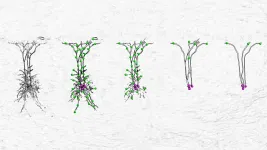Historically redlined neighborhoods are more likely to lack greenspace today
2021-01-27
(Press-News.org) Historically redlined neighborhoods are more likely to have a paucity of greenspace today compared to other neighborhoods. The study by researchers at Columbia University Mailman School of Public Health and the University of California, Berkeley and San Francisco, demonstrates the lasting effects of redlining, a racist mortgage appraisal practice of the 1930s that established and exacerbated racial residential segregation in the United States. Results appear in Environmental Health Perspectives.
In the 1930s, the Home Owners' Loan Corporation (HOLC) assigned risk grades to neighborhoods across the country based on racial demographics and other factors. "Hazardous" areas--often those whose residents included people of color--were outlined in red on HOLC maps. In the decades since, redlined neighborhoods experienced lower levels of private and public investment and have remained segregated.
Mounting evidence indicates that historically redlined neighborhoods contributed to worse health outcomes, as well as elevated exposures to air pollution and other environmental hazards. Areas lacking green space often also have elevated levels of air and noise pollution, as well as higher rates of racial segregation and poverty.
"Though redlining is now outlawed, its effects on urban neighborhoods persist in many ways, including by depriving residents of green space, which is known to promote health and buffer stress," says first author Anthony Nardone, MS, a medical student at the University of California, San Francisco.
"We find lingering effects of racist redlining policies from the 1930s. Future policies should, with the input of local leaders, strive to expand the availability of green space, a health-promoting amenity, in communities of color," adds senior author Joan Casey, PhD, assistant professor of environmental health sciences at the Columbia Mailman School.
The researchers examined 72 urban areas in the United States, estimating the association between HOLC grades and greenspace, as measured by satellite imagery from 2010. They compared greenspace between neighborhoods with different HOLC grades but otherwise similar sociodemographic characteristics according to the 1940s Census so as to isolate the effect of HOLC grades, including redlining. They limited their analysis to neighborhoods that overlapped with 1940 census tract boundaries and considered ecoregion because greenspace will be qualitatively different in, for example, the Southwest compared to the Northeast.
HOLC risk grades were one part of a larger pattern of racist policies. The Federal Housing Administration, tasked with stimulating the private real estate market during the New Deal, would not underwrite insurance on private mortgages that would have desegregated neighborhoods. Similarly, racially restrictive covenants, which were clauses in homeownership deeds, prohibited the future sale of many homes to people of color. More recently--even after the passage of the 1968 Fair Housing Act, which explicitly made redlining illegal--racist banking and real estate practices have persisted and are reflected by the fallout of the subprime mortgage crisis, in which those in communities of color, particularly Black and Latino individuals, were disproportionately targeted with predatory loans and foreclosures by banks.
The authors note that their analysis of satellite imagery does not provide an indication of greenspace quality (for example, green space in places with arid climates may not be reasonable proxies for vicinity to natural environments and their health-related benefits). They also do not distinguish between public and private greenspace or untended forest and manicured parks. In some areas, the presence of green space in the 1930s may also have decreased the likelihood that a neighborhood was redlined.
The researchers say future studies could apply similar methods to analyze metropolitan- and regional-specific associations and assess the extent to which state, county, or city-level policies may modify observed relationships between HOLC grade and green space. Co-authors include Kara E. Rudolph at Columbia University and Rachel Morello-Frosch at the University of California, Berkeley.
INFORMATION:
Funding was provided by the United States Environmental Protection Agency (RD83543301), the National Institutes of Environmental Health Sciences (ES027023, ES009089, ES02284, OD023272, OD023272), and from the National Institutes of Health Environmental influences on Child Health Outcomes (ECHO) program.
ELSE PRESS RELEASES FROM THIS DATE:
2021-01-27
LAWRENCE -- For at least a century, ecologists have wondered at the tendency for populations of different species to cycle up and down in steady, rhythmic patterns.
"These cycles can be really exaggerated -- really huge booms and huge busts -- and quite regular," said Daniel Reuman, professor of ecology & evolutionary biology at the University of Kansas and senior scientist at the Kansas Biological Survey. "It attracted people's attention because it was kind of mysterious. Why would such a big thing be happening?"
A second observation in animal populations ...
2021-01-27
(Boston)--Researchers from Boston University School of Medicine (BUSM) have identified proteins that are essential for the viability of whole genome doubled tumor cells, yet non-essential to normal cells that comprise the majority of human tissue.
"Exploiting these vulnerabilities represents a highly significant and currently untapped opportunity for therapeutic intervention, particularly because whole genome doubling is a distinguishing characteristic of many tumor types," said corresponding author Neil J. Ganem, PhD, associate professor of pharmacology and medicine, section of hematology and medical oncology, at Boston University School of Medicine (BUSM).
The vast majority of human cells are diploid, meaning that they possess two copies of each ...
2021-01-27
The Asia Pacific Consortium on Osteoporosis (APCO) has today launched the first pan-Asia Pacific clinical practice standards for the screening, diagnosis, and management of osteoporosis, targeting a broad range of high-risk groups.
Published in Osteoporosis International today, 'The APCO Framework' comprises 16 minimum clinical standards set to serve as a benchmark for the provision of optimal osteoporosis care in the region.
Developed by APCO members representing key osteoporosis stakeholders, and multiple medical and surgical specialities, this set of clear, concise, relevant and pragmatic clinical standards aims to support national societies, guidelines development authorities, and health care policy makers with ...
2021-01-27
People who take opioid medications for chronic pain may have a hard time finding a new primary care clinic that will take them on as a patient if they need one, according to a new "secret shopper" study of hundreds of clinics in states across the country.
Stigma against long-term users of prescription opioids, likely related to the prospect of taking on a patient who might have an opioid use disorder or addiction, appears to play a role, the University of Michigan research suggests.
Simulated patients who said their doctor or other primary care provider had retired were more likely to be told they could be accepted as new patients, compared with those who said their provider had stopped prescribing opioids to them for an unknown reason.
The U-M primary care provider ...
2021-01-27
Neurons, the fundamental units of the brain, are complex computers by themselves. They receive input signals on a tree-like structure - the dendrite. This structure does more than simply collect the input signals: it integrates and compares them to find those special combinations that are important for the neurons' role in the brain. Moreover, the dendrites of neurons come in a variety of shapes and forms, indicating that distinct neurons may have separate roles in the brain.
A simple yet faithful model
In neuroscience, there has historically been a tradeoff between a model's faithfulness to the underlying biological neuron and its complexity. Neuroscientists have constructed ...
2021-01-27
Being constantly flooded by a mass of stimuli, it is impossible for us to react to all of them. The same holds true for a little fish. Which stimuli should it pay attention to and which not? Scientists at the Max Planck Institute of Neurobiology have now deciphered the neuronal circuit that zebrafish use to prioritize visual stimuli. Surrounded by predators, a fish can thus choose its escape route from this predicament.
Even though we are not exposed to predators, we still have to decide which stimuli we pay attention to - for example, when crossing a street. Which cars should we avoid, which ones can we ignore?
"The ...
2021-01-27
A massive simulation of the cosmos and a nod to the next generation of computing
A team of physicists and computer scientists from the U.S. Department of Energy's (DOE) Argonne National Laboratory performed one of the five largest cosmological simulations ever. Data from the simulation will inform sky maps to aid leading large-scale cosmological experiments.
The simulation, called the Last Journey, follows the distribution of mass across the universe over time -- in other words, how gravity causes a mysterious invisible substance called "dark matter" to clump ...
2021-01-27
Many genetic mutations have been found to be associated with a person's risk of developing Parkinson's disease. Yet for most of these variants, the mechanism through which they act remains unclear.
Now a new study in Nature led by a team from the University of Pennsylvania has revealed how two different variations--one that increases disease risk and leads to more severe disease in people who develop Parkinson's and another that reduces risk--manifest in the body.
The work, led by Dejian Ren, a professor in the School of Arts & Sciences' Department of Biology, showed that the variation that raises disease risk, which about 17% of people possess, causes a reduction in function of an ion channel ...
2021-01-27
Dr. Richi Gill, MD, is back at work, able to enjoy time with his family in the evening and get a good night's sleep, thanks to research. Three years ago, Gill broke his neck in a boogie board accident while on vacation with his young family. Getting mobile again with the use of a wheelchair is the first thing, Gill says, most people notice. However, for those with a spinal cord injury (SCI), what is happening inside the body also severely affects their quality of life.
"What many people don't realize is that a spinal cord injury prevents some systems within the body from regulating automatically," ...
2021-01-27
Among infectious diseases that have caused pandemics and epidemics, smallpox stands out as a success story. Smallpox vaccination led to the disease's eradication in the twentieth century. Until very recently, smallpox vaccine was delivered using a technique known as skin scarification (s.s.), in which the skin is repeatedly scratched with a needle before a solution of the vaccine is applied. Almost all other vaccines today are delivered via intramuscular injection, with a needle going directly into the muscle, or through subcutaneous injection to the layer of tissue beneath the skin. But Thomas Kupper, MD, chair of the Department of Dermatology, and colleagues, had reason to suspect that vaccines delivered ...
LAST 30 PRESS RELEASES:
[Press-News.org] Historically redlined neighborhoods are more likely to lack greenspace today




